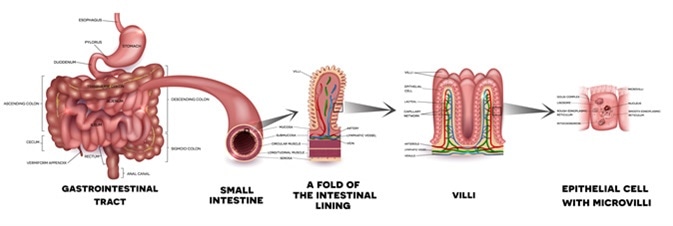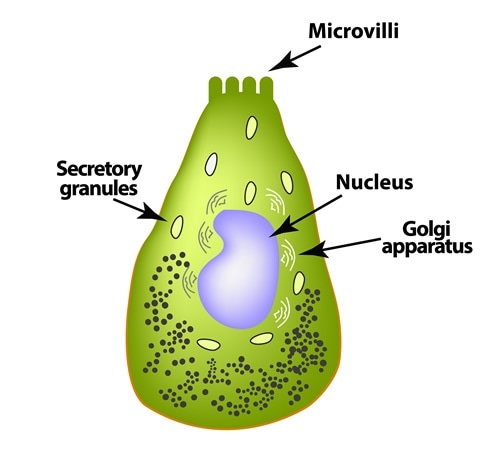For What Reason Does The Small Intestine Have Specialized Features To Increase Surface Area?
The minor intestine is a tubular structure within the intestinal crenel that carries the food in continuation with the stomach upward to the colon from where the large intestine carries it to the rectum and out of the body via the anus. The main role of this organ is to assistance in digestion.
How large is the small intestine?
Every bit a person grows the small intestine increases 20 times in length from almost 200 cm in a newborn to almost 6 g in an adult. The length of the small intestine is approximated past three times the length of the infant, or pinnacle of the kid or developed.
The duodenum is most 25 cm (10 inches) long; the jejunum is most 2.5 m (8 feet) long and the ileum is about 3.6 m (12 anxiety) long.
Anatomy of the minor intestine
The small intestine begins with the duodenum. The duodenum begins at the duodenal bulb and goes around the head of the pancreas and ends every bit it returns to the peritoneal cavity at the ligament of Treitz. The peritoneal cavity is a thin membrane crenel that covers the organs within the abdomen with some exceptions.

The residual of the small intestine is suspended within the peritoneal cavity by a sparse, broad-based mesentery that is attached to the posterior abdominal wall. This allows free movement of the pocket-sized intestine within the abdominal cavity.
After the duodenum comes the adjacent twoscore% of the mobile small intestine called the jejunum. The remaining 60% is the ileum.
The jejunum occupies the left upper portion of the abdomen while the ileum is positioned in the correct side and upper role of the pelvis.
The inner walls of the small intestine show mucosal folds. These are chosen the plicae circulares. The plicae are more numerous in the early on jejunum and reduce in numbers in the after function and are completely absent in the ileum.
Absorption takes identify via primary cell type of the epithelial layer. Goblet cells, located throughout the epithelial layer, secrete mucus that helps protect the epithelial layer from digestion.
Enteroendocrine cells secrete hormones into blood vessels that penetrate each villus. Paneth cells, located in the epithelial layer facing the intestinal crypts, secrete lysozyme, an enzyme that destroys bacteria. An inner core of lamina propria (connective tissues) contains claret capillaries and small lymphatic capillaries called lacteals.

Enteroendocrine cell
The submucosa under the mucosa contains Brunner's (duodenal) glands, found only in the submucosa of the duodenum. It secretes an alkaline fungus that neutralizes the gastric acid in the incoming chyme.
Aggregates of lymphoid follicles are scattered throughout the small intestine but are found in highest concentration within the ileum, where they are designated Peyer'southward patches. These are more prominent among children and infants. The small intestine ends at the ileocecal valve that leads it to the colon. The ileocecal valve provides a barrier to the back menstruum of the colonic contents into the small intestine.
The wall of the minor intestine and colon is composed of four layers: mucosa (or mucous membrane), submucosa, muscularis (or muscularis propria), and adventitia (or serosa).
Functions of the small intestine
The small intestine is the part of the intestines where 90% of the digestion and absorption of nutrient occurs, the other 10% taking place in the stomach and large intestine. The chief function of the pocket-sized intestine is absorption of nutrients and minerals from food.
Digestion involves 2 distinct parts. The first is mechanical digestion past chewing, grinding, churning and mixing that takes place in the mouth and the breadbasket. The 2nd part of digestion is the chemic digestion that uses enzymes, bile acids etc. in guild to pause down food material into a grade that tin and so be absorbed, then assimilated into the tissues of the trunk. Chemical digestion occurs in the small intestine (and, to a lesser extent, also in some other office of the gastrointestinal tract.
Digestion of proteins
Proteins, peptides and amino acids are acted upon by enzymes such as trypsin and chymotrypsin, secreted past the pancreas. This breaks them down to smaller peptides. Chemical breakdown begins in the stomach and continues until the large intestine.
Digestion of lipids
Enzymes, like lipases secreted from the pancreas, act on fats and lipids in diet. This breaks the triglycerides into free fatty acids and monoglycerides. It is helped by bile salts secreted by the liver and the gall float. The lipase is soluble in water but the fat triglycerides are non. The bile salts concur the triglycerides in the watery environment until the lipase can break them into the smaller parts that tin can enter the intestinal villi for absorption.
Digestion of carbohydrates
Carbohydrates are broken down to simple sugars and monosaccharides like glucose. Pancreatic amylase breaks down some carbohydrates to oligosaccharides every bit well. Some carbohydrates and fibers pass undigested to the large intestine where they may, depending on their type, be broken-downward by intestinal leaner.
Absorption in the small intestines
Once broken down the nutrients are absorbed by the inner walls of the small intestine into the blood stream. The nutrients are rendered pocket-sized plenty so that they may pass, or "be transported", beyond the epithelial cells of the alimentary canal. The nutrients are absorbed past processes of simple/passive diffusion, facilitated diffusion, master active ship, or secondary agile send.
The small intestine is adept for absorption since it has a large inner surface area. This is formed due to the plicae circulares which project many tiny finger-like structures of tissue called villi. The individual epithelial cells also have finger-like projections, which are called known every bit microvilli.
For send, nutrients usually rely upon:
- Lipids – undergo passive or simple diffusion
- Short-concatenation fatty acids – diffusion
- Amino acids – primary active transport
- Glucose – secondary active ship
- Fructose – facilitated improvidence
Other absorbed substances in the modest intestines include:
Water
Most of the h2o in ingested food and beverages is absorbed past osmosis.
Approximately 80% is absorbed by the small intestine, 10% by the big intestine and the remaining 10% excreted in the faeces.
Electrolytes
Of these sodium is absorbed by diffusion and agile transport. Chloride (Cl-) is captivated passively along with sodium or actively transported. Iodine (I-) and Nitrate (NO3-) can passively follow Na+ ions or are absorbed actively. Calcium ions (Ca2+) are captivated actively in a process stimulated by calcitriol (agile course of Vitamin D). Iron ions (Fe2+ and Fe3+), Potassium ions (K+), Magnesium ions (Mg2+) and Phospate ions (PO43-) are absorbed by active transport mechanisms.
Vitamins and minerals
Vitamins including fatty soluble ones (Vitamins A, D, E and K) are captivated together with dietary fats. Water soluble vitamins like vitamins B and C are captivated by diffusion. Vitamin B12 combined with intrinsic gene (from the stomach) is captivated by agile transport.
Of these iron is captivated in the duodenum, about are absorbed in the jejunum and Vitamin B12 and bile salts are absorbed in the afterwards office of the ileum.
Disorders of the small-scale intestine
Some of the disorders of the modest intestine include:
- Obstruction of the small intestine. This may occur due to external pressure, masses in the lumen (strange bodies, bezoar, gallstones), paralytic ileus, Crohn's affliction, Celiac illness, Carcinoid, Meckel'due south Diverticulum, Gastric dumping syndrome, inguinal hernia, intussuseption, mesenteric ischemia etc.
- Infections including Giardiasis, Ascariasis, Tropical sprue, Tape worm infestation etc.
- Pocket-size intestine cancer
Farther Reading
- All Small Intestine Content
For What Reason Does The Small Intestine Have Specialized Features To Increase Surface Area?,
Source: https://www.news-medical.net/health/What-Does-the-Small-Intestine-Do.aspx
Posted by: gallowaycomen2001.blogspot.com


0 Response to "For What Reason Does The Small Intestine Have Specialized Features To Increase Surface Area?"
Post a Comment